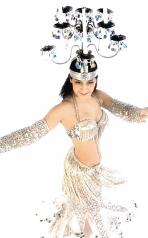About Shamadan (Candelabras)
Below you will find information on dancing with a Shamadan or candelabra in bellydance.
Raqs as-Shamadan (رقص الشمعدان) is an Egyptian dance traditionally done during the zeffah al-aroos (زفة العروس - "bridal procession" usually referred to simply as zeffah) procession of a wedding. During a zeffah the bride and groom are traditionally transported from the brides home to her new home with husband. Modern processions often circle the lobby or banquet hall of a wedding club or hotel. The procession is led by a dancer who generally plays sagat (finger cymbals), musicians, and singers. This is followed by the wedding couple and then their family members. This zeffah tradition is very old in Egypt but the use of a candelabra is more recent. It traces it's origins somewhere between the late 1800's to early 1900's. It's exact date of origin is uncertain but somewhere between 1870 and 1920 is likely. It started with a dancer by the name of Zouba al-Klobatiya (زوبة الكلوباتية) who balanced a lantern called a "klob" (from which her "last name" is derived) on her head during a wedding procession. This became her specialty. Zeffa's traditionally had people holding lanterns and candles to light the way. The candles supposedly symbolize light, love, and prosperity while dancers at weddings have often been said to symbolize fertility. Another dancer from about the same time by the name of Shafiqa al-Qobtiya (شفيقه القبطيه) or Shafiqa the Coptic (the main type of Christianity in Egypt) decided to be competitive and started balancing a candelabra. She was already a very famous dancer in the wedding and moulid (saint's day celebrations) circle and her new specialty of balancing a candelabra on her head was quickly in high demand.
Other dancers from Muhammad Ali street started imitating it as the popularity of this style grew. Shafiqa soon entertained upper-class citizens and royalty with her Shamadan dance and of course this made it even more popular. Everyone wanted to have Shamadan even if it wasn't done by the famous Shafiqa. Soon it became a tradition spreading from out from Cairo in all directions. Shafiqa and Zouba both trained others in the art of Shamadan. Most notably they trained Najia el Eskandrani and her sister Dawlett. Dawlett then passed this training on to her grandchildren producing another generation of fabulous Shamadan dance though her granddaughter Nadia Hamdi (نادية حمدي). Shamadan has developed into both a procession and a solo stage performance which generally features a large floorwork segment. It's classified in Egypt as folkloric and as such it can go around the restrictions banning floorwork in raqs sharqi performances. It is one of the few legal ways to perform floorwork in Egypt. Dancers in general however, have been on a decline at wedding parties. More conservative religious views and economic hardships work in tandem discouraging the hiring of dancers. Sometimes weddings have had violent outbursts over the presence of a dancer leading many to say it's just not worth it. Instead they opt for less controversial entertainers who perform dances such as tanoura or tahtib. Sometimes they opt for music or nasheed performances only. This of course has lead to a major decrease in Shamadan. It is now mostly seen in staged performances and is unfortunately a lot harder to find.
Shamadan has become a popular style for dancer outside of Egypt too. Even thought this style of dance and the Zeffa are Egyptian the practice has also found it's way into neighboring Middle Eastern and North African countries probably in part due to the popularity and availability of Egyptian media throughout the region. Dancers in the US and other western countries have also fallen in love with shamadan and perform it as a specialty for weddings here in the us both for Arabs and non-Arabs as well as a theatrical stage piece. It is almost always done with the zeffah rhythm at least to enter with although some people use something different once they start the solo performance and floorwork. Usually the music will still be Egyptian although some dancers have paired it with things like new age music. The traditional music is of course only Zeffa.

